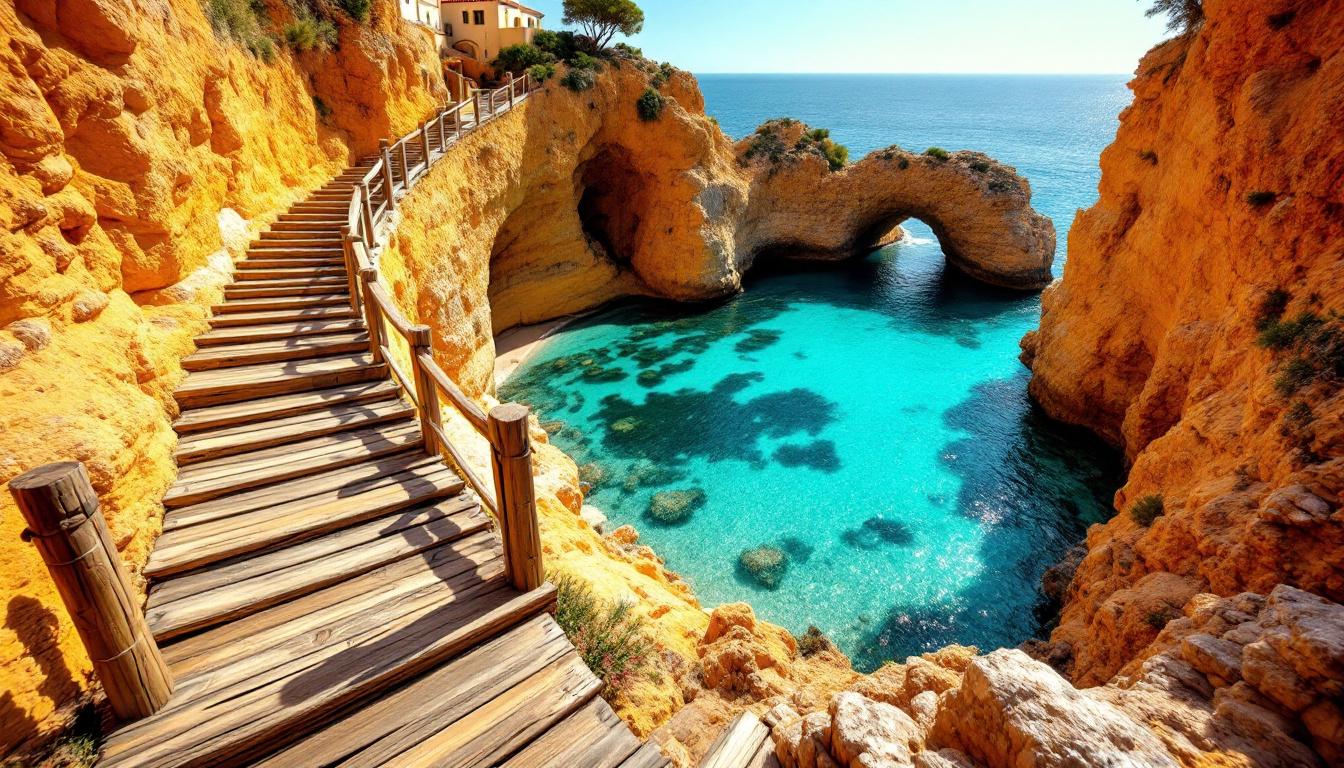Standing at the edge of Lagos’ golden cliffs, watching tourists hesitate before a weathered wooden staircase plunging down the rock face, I realized most travelers completely misunderstand what 200 steps actually means. While everyone assumes this Portuguese beach requires serious hiking endurance, the reality creates one of Europe’s most delightful accessibility surprises.
Praia do Camilo isn’t remotely inaccessible—it’s actually easier to reach than most people imagine. The wooden staircase descent takes just 8-10 minutes for average visitors, with stunning clifftop views transforming each step into visual reward rather than physical challenge.
What locals in Lagos have discovered is that these stairs serve as a natural filter, keeping their favorite beach intimate while remaining perfectly manageable for anyone with basic mobility. The “difficulty” exists more in perception than reality.
The wooden staircase that transforms fear into joy
Why 200 steps feel easier than expected
Portuguese coastal engineering creates staircases that work with natural cliff contours rather than fighting them. Unlike steep urban steps, these wooden stairs follow the natural slope with comfortable rise-to-run ratios that make descent surprisingly gentle. Each landing offers rest points with increasingly spectacular ocean views that make you forget you’re exercising.
The psychological shift halfway down
Most visitors experience a complete mindset transformation around step 100. The initial apprehension melts away as crystal-clear turquoise water comes into focus below, while the natural amphitheater of golden cliffs creates an almost theatrical reveal. By step 150, you’re no longer thinking about the climb back up—you’re planning your beach strategy.
What makes this beach worth every single step
The intimate scale that stairs protect
This natural access control keeps Praia do Camilo at around 50-70 daily visitors even in late summer, compared to 300+ at nearby Praia da Rocha. The small sandy cove, roughly 200 meters long, offers personal space that feels impossible to find elsewhere along the Algarve coast during peak season.
The hidden tunnel adventure awaiting below
Once you reach the sand, a natural stone archway carved by centuries of Atlantic waves leads to an even smaller adjacent cove. This geological tunnel, barely mentioned in guidebooks, creates a sense of private discovery that transforms a simple beach visit into genuine exploration.
Smart logistics that eliminate staircase stress
The preparation that prevents problems
Local wisdom suggests visiting the clifftop restaurant and facilities before descending, since no services exist on the beach itself. Arriving by 9am means tackling stairs with fresh energy while securing prime positioning before afternoon crowds. The €3 parking fee at the clifftop includes all-day access.
The ascent strategy that actually works
Experienced Lagos visitors climb back up during the golden hour around 6pm, when cooler temperatures and magical lighting make the ascent genuinely pleasant. Many stop halfway at natural viewing platforms, turning the return journey into a sunset photography session rather than pure physical effort.
Why accessibility fears miss the cultural point
Portuguese coastal tradition that welcomes visitors
These wooden staircases represent centuries-old Portuguese maritime culture where fishermen built similar cliff access for boat launches. The construction preserves traditional craftsmanship while providing modern safety features like sturdy handrails and regular maintenance by Lagos municipal teams.
The sustainable tourism model other destinations need
Rather than building elevators or road access that would destroy the clifftop ecosystem, this staircase solution maintains environmental integrity while keeping the beach accessible. It’s become a model for sustainable coastal tourism that other Mediterranean destinations are now studying.
What initially appears challenging at Praia do Camilo becomes the gateway to one of Portugal’s most rewarding beach experiences. The 200-step wooden staircase isn’t an obstacle—it’s the entrance to a coastal sanctuary that remains authentic precisely because it requires a small physical investment.
For September 2025 visitors, these stairs offer something increasingly rare in European beach tourism: genuine intimacy with nature that feels both accessible and exclusive. Portugal’s hidden coastal gems consistently deliver experiences that exceed expectations, while Mediterranean cliff towns often disappoint with overcrowding. The beauty lies in discovering that remote beach destinations can be surprisingly reachable when you know what to expect.
Essential questions about Praia do Camilo access
How long does the staircase descent actually take?
Most visitors complete the 200-step descent in 8-12 minutes, with the ascent taking 12-15 minutes including photo stops. Physical fitness matters less than comfortable shoes and reasonable pacing.
Are there any facilities once you reach the beach?
No facilities exist on Praia do Camilo itself—no restaurants, toilets, or equipment rentals. All services remain at the clifftop level, making pre-descent preparation essential.
What’s the best time to tackle the stairs?
Early morning (8-9am) offers the easiest descent with fresh energy, while late afternoon ascents (5-6pm) benefit from cooler temperatures and stunning golden hour lighting for photography.
Is the staircase safe for children and older adults?
The wooden staircase features proper handrails and regular maintenance, making it safe for most ages with basic mobility. However, the length and incline require reasonable physical capability and comfortable footwear.
How does this compare to other Algarve beach access?
Most Algarve beaches offer direct car access or short walks. Praia do Camilo’s staircase is uniquely challenging but rewards visitors with dramatically reduced crowds and pristine natural settings unavailable at easily accessible beaches.
